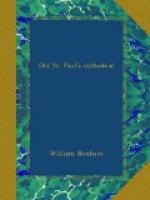his episcopate, was Archdeacon of Rochester, a very
wise and energetic administrator. He was now on
the side of Rich, bent on defending his clergy from
being over-ridden by the foreigners. He exerted
himself as bishop not only to repair the mischief
done by the storm, but to enlarge and beautify the
still unfinished structure. Fourteen years later
King Henry was offering devotion at the shrine of
Rich, for he had been canonised, and that on the strength
of his having resisted the King’s criminal folly
in betraying the rights of his people; for by this
time the nation was aroused. The Londoners rose
and burned the houses of the foreigners. Bishop
Roger, though he, of course, declared against the scenes
of violence, let it be seen that he was determined,
by constitutional methods, to defend his clergy from
being plundered. On his death, in 1241, there
was a long vacancy, the King wanting one man and the
canons determined on another, and they carried their
man, Fulk Bassett, though he was not consecrated for
three years. Pope Innocent IV., in 1246, sent
a demand of one-third of their income from the resident
clergy, and half from non-resident. Bishop Fulk
indignantly called a council at St. Paul’s,
which declared a refusal, and even the King supported
him. The remonstrance ended significantly with
a call for a General Council. But he was presently
engaged in a more serious quarrel. The King forced
the monks of Canterbury, on the death of Edmund Rich,
to elect the queen’s uncle, Boniface of Savoy,
to the primacy. He came and at once began to
enrich himself, went “on visitation” through
the country demanding money. The Dean of St.
Paul’s, Henry of Cornhill, shut the door in his
face, Bishop Fulk approving. The old Prior of
the Monastery of St. Bartholomew, Smithfield, protested,
and the Archbishop, who travelled with a cuirass under
his pontifical robe, knocked him down with his fist.[2]
Two canons, whom he forced into St. Paul’s chapter,
were killed by the indignant populace. The same
year (1259) brave Bishop Fulk died of the plague.
For years the unholy exactions went on, and again and
again one has records of meetings in St. Paul’s
to resist them.
When Simon de Montfort rose up against the evil rule
of Henry III. the Londoners met in folkmote, summoned
by the great bell of St. Paul’s, and declared
themselves on the side of the great patriot. They
are said to have tried to sink the queen’s barge
when she was escaping from London to join the King
at Windsor.
King Edward I. demanded a moiety of the clerical incomes
for his war with Scotland. The Dean of St. Paul’s
(Montfort) rose to protest against the exaction, and
fell dead as he was speaking. Two years later,
the King more imperiously demanded it, and Archbishop
Winchelsey wrote to the Bishop of London (Gravesend)
commanding him to summon the whole of the London clergy
to St. Paul’s to protest, and to publish the
famous Bull, “clericis laicos,” of Pope
Boniface VIII., which forbade any emperor, king, or




